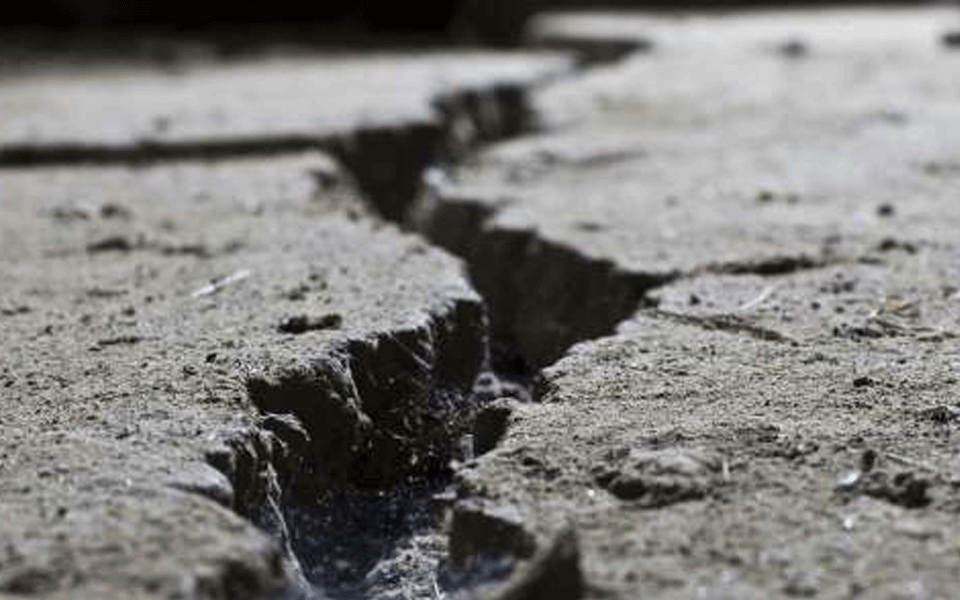Jakarta, Apr 12: A strong 6.8 magnitude earthquake rocked eastern Indonesia Friday, the United States Geological Survey said, triggering a tsunami warning and sending panicked residents fleeing from their homes.
The quake struck at a relatively shallow depth of 17 kilometres off the east coast of Sulawesi island, the USGS said, where a 7.5-magnitude quake-tsunami around the city of Palu killed more than 4,300 people last year.
Indonesia's geophysics agency issued a tsunami warning for coastal communities in Morowali district, but there were not immediate reports of casualties or damage.
But the USGS warned that considerable damage was possible in poorly built or badly designed structures.
The quake hit off the coast of eastern Sulawesi, on the other side of the island from disaster-hit Palu, where residents still felt the tremor despite being hundreds of kilometres away.
"I ran straight outside after the earthquake -- everything was swaying," 29-year-old Palu resident Mahfuzah told AFP.
Thousands in Palu were living in makeshift shelters six months after the late September disaster with at least 170,000 residents of the city and surrounding districts displaced and entire neighbourhoods still in ruins, despite life returning to normal in other areas of the tsunami-struck city.
The force of the quake saw entire neighbourhoods levelled by liquefaction -- a process where the ground starts behaving like a liquid and swallows up the earth like quicksand.
Apart from the damage to tens of thousands of buildings, the disaster destroyed fishing boats, shops and irrigation systems, robbing residents of their income.
Indonesia has said the damage bill in Palu topped 900 million. The World Bank has offered the country up to 1 billion in loans to get the city back on its feet.
Indonesia is one of the most disaster-prone nations on Earth due to its position straddling the so-called Pacific Ring of Fire, where tectonic plates collide.
Last year was a particularly tough one, however, with more than 2,500 disasters ranging from a series of deadly earthquakes to killer landslides and volcanic eruptions.
The sprawling archipelago is dotted with more than 100 volcanoes, including one in the middle of the Sunda Strait between Java and Sumatra islands that erupted in late 2018 and unleashed a tsunami that killed more than 400 people.
Let the Truth be known. If you read VB and like VB, please be a VB Supporter and Help us deliver the Truth to one and all.
Chennai (PTI): Streaming service JioHotstar on Tuesday announced that it will invest Rs 4,000 crore over the next five years to strengthen South India’s creative economy, unveiling a 25-title slate as part of a major push for regional content.
In one of the biggest announcements by an Indian streaming platform for the southern markets, the company showcased its “South Unbound” vision at a high-profile event here.
Sushant Sreeram, Head – SVOD Business & Chief Marketing Officer at JioStar, said the investment forms part of a broader collaboration with the Tamil Nadu government.
“Earlier today, JioHotstar formalised a Letter of Intent with the Government of Tamil Nadu in the presence of the Chief Minister M K Stalin. This outlines a shared commitment to invest in talent, expand infrastructure and build a future-ready creative economy from the South.
"As part of this vision, JioHotstar will invest Rs 4,000 crore to nurture creators, strengthen the production ecosystem and build a pipeline of stories that are ready for India and ready for the world,” he said.
Calling South India the “heartbeat of Indian storytelling”, Sreeram said the investment signalled the platform’s long-term commitment to local creators.
"JioHotstar started as a dream — to build entertainment rooted in India’s storytelling heritage and powered by cutting-edge technology. The resplendent storytelling traditions of the South motivate us to keep championing authentic, rooted narratives while offering greater accessibility and choices for every viewer," he said.
The event was attended by Tamil Nadu Deputy Chief Minister Udhayanidhi Stalin, veteran actor and MP Kamal Haasan, senior state officials, and leading stars and filmmakers from across the southern industries.
Deputy CM Stalin said the partnership will generate “1,000 direct jobs and 15,000 indirect jobs”.
“Cinema in Tamil Nadu has always been a force for social change. OTT is not replacing cinema; it is expanding it. Today, a filmmaker in Madurai or Salem can upload a story and reach audiences across the world. The cultural and economic impact of this partnership will be massive," he added.
aasan said Indian media and entertainment was undergoing a fundamental transformation driven not by technology alone, but by the audience itself.
“We gather at a moment when India’s media and entertainment is not merely growing, it is transforming. For the first time, this shift is not driven by device or format, but by the audience itself,” he said, adding that storytelling today is “screen agnostic”.
“Regional is becoming the new national, and ethnic the new international. Stories born in Madurai, Malappuram or Machilipatnam are no longer regional cinema; they are national cultural events,” Haasan said, giving the example of movies such as “Kantara”, “Drishyam”, “Baahubali”, “Pushpa” and Tamil hits like “Vikram”.
The event was also attended by Mohanlal, Nagarjuna, Vijay Sethupathi, Priyamani, Aishwarya Rajesh and others -- along with directors Jeethu Joseph and Ahammed Khabeer
The streamer's ambitious content slate, unveiled as part of its “South Unbound” initiative, includes sequels to blockbuster franchises, new long-format shows, films, adaptations, and high-engagement reality formats.
The Tamil slate features a mix of returning favourites and new originals, led by "Bigg Boss Tamil", now hosted by Vijay Sethupathi, and "Good Wife S2", the legal drama starring Priyamani.
The lineup also includes "LBW – Love Beyond Wicket", a relationship drama; the family comedy "Cousins and Kalyanams"; the psychological drama "Resort"; and "Heartbeat S3", which brings back Anumol, Karthik Kumar and Deepa Balu.
Other Tamil offerings include "Lingam", an action-drama; "Love Always", a multigenerational love story; the marquee title "Kaattaan" starring Vijay Sethupathi and Milind Soman; and "Second Love", a non-fiction relationship series.
In Telugu, the platform returns with "Bigg Boss Telugu" hosted by Nagarjuna, alongside new originals such as "Moodu Lantharlu" starring Aishwarya Rajesh; the police procedural "Vikram on Duty"; "Varam", a mystical relationship drama; and the hit comedy-drama "Save The Tigers S3" with Chaitanya Krishna.
The slate further includes "Vishakha", the Telugu adaptation of "Aarya" led by Kajal Aggarwal; the relationship-based non-fiction format "Mad for Each Other"; and the Telugu debut of the iconic adventure franchise "Roadies".
From Malayalam, the platform brings back "Bigg Boss Malayalam" hosted by Mohanlal; "Kerala Crime Files S3" featuring Aju Varghese; the mystery drama "Secret Stories: Roslin"; "Anali", "1000 Babies S2" with Neena Gupta and Rahman; and the hard-hitting drama "Pharma" starring Nivin Pauly.
The Kannada lineup includes "Bigg Boss Kannada" hosted by Kichcha Sudeepa; "Batchmates", a nostalgic friendship drama; and the food-and-humour-based non-fiction series "Comedy Cooks".
Across languages, the platform also announced new films such as "Lucky The Superstar", featuring GV Prakash, Anaswara Rajan and Meghna Sumesh, and "Kenatha Kaanom", positioned as broad-appeal mainstream entertainers.





